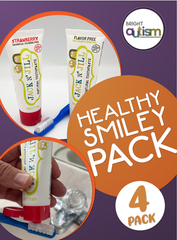
Although a trip to the dentist can cause most children to feel a bit anxious, a trip to the dentist for kids with autism spectrum disorder (ASD) or individual sensory issues can be traumatic in a much different way. There are many different sounds, sights, and smells in a dentist office that can cause them great difficulty. The sound of dental equipment, the bright lights, and strangers all hovering in close proximity could cause your child to stim, scream, or even try to escape from the chair. For many parents, autism and dental care don’t seem to mix.
However, making regular trips to the dentist is an incredibly important part of building a good oral health program for children.
Preparing for your Dental Visit

Preparing children under the spectrum for their trip to the dentist well in advance can be very helpful in easing anxiety and having a calm and successful visit. Many offices will allow you to schedule a tour in the weeks or days ahead of your actual appointment so your child will feel more comfortable in that setting. Be sure to discuss your child’s individual needs, concerns, or challenges with the dentist or staff before the appointment.
A visual schedule, or social story, may be very helpful in preparing children for their visit to the dentist. As with the sensory avoidance routine, it will help to practice each step until your child understands and feels comfortable with each part of the process before moving on.

You may find it helps to break the process into smaller, repeatable steps. For instance, you and your child may make the trip to the dentist, meet the front-desk staff, and sit in the chair without receiving treatment, then go home with a prize. This gradual approach may be helpful in alleviating anxiety and promoting familiarity.
A Visual Schedule for a Trip to the Dentist
Below is a sample schedule for a trip to the dentist:
- We will be visiting the Dentist today to make sure my teeth and mouth are nice, clean, and healthy.
- We’ll walk into the office and tell our names to the people at the front desk.
- Until they call my name, we will play games, color, or watch television.
- The hygienist will call my name and walk with me to a room with lots of special chairs.
- The special chair will move up and down and lean back so the Dentist can look in my mouth.
- When I sit in the chair, I’ll keep my hands on my belly and put my legs and feet straight out in front of me.

- I’ll open my mouth as wide as I can so the Dentist can look inside. There will be a bright light so they can see. I can ask for special sunglasses or close my eyes if it is too bright.
- The Dentist will count my teeth with a special mirror. It may tickle a little.
- The Dentist will take special pictures of my teeth called X-Rays. I may have to sit down in a different chair and wear a heavy apron to take these pictures.
- The Dentist will clean my teeth with special tools. They will show me each one and tell me what they are for before we use them.
- When all my teeth are clean I will spit into the sink.
- The Dentist will give me a special bag with a new toothbrush and toothpaste. I’ll also get a special prize when I leave the office.
Sensory-Seeking Children

For sensory seeking children, brushing their teeth may be helpful in providing a calming effect. Parents can sing a song like “This is the Way We Brush Our Teeth” (Set to the tune of “Here We Go ‘Round the Mulberry Bush”) to make sure their child spends enough time brushing their teeth.
For children that are sensory avoiders, reluctance may be because of the taste of the toothpaste, the sensation in and around their mouth, or a combination of factors. Unflavored toothpaste may be helpful for children where taste is the primary objection.
Toothbrushing Tolerance for Sensory Avoiders

Dental visits for children with autism and special needs are important to have every six months, but healthy habits start at home!
Regular brushing is essential to maintaining a child’s oral health, but some children may experience some difficulties in doing so. Most children require a parent’s assistance in brushing their teeth until they are a bit older. To help your child become more comfortable in brushing their teeth or having their teeth brushed, consider a gradual approach in assisting them. You can move on to each step in the routine once your child feels comfortable with the previous step. Dentists recommend that all children should be actively supervised when brushing their teeth up until the age of 7-8 years of age.

Here are some tips to help make brushing your child’s teeth a little easier:
- Start by applying gentle pressure to the back of their head for a period of five seconds, repeating three times. Do this three to five times per day, preferably where your child will be brushing their teeth. This will help them become accustomed to the feelings they’ll experience during dental appointments and daily brushing.
- While most people brush their teeth in their bathroom, you may choose to perform the activity in another area of the home where your child feels more comfortable. If you’re assisting your child in brushing, it is easier to have them lie down in your lap or lie back in a chair, much like we do during their dental appointment. Children are more likely to remain still since they are more comfortable.

- Once your child is comfortable with pressure on the back of their head, you can begin to extend the routine by applying pressure to other areas of the head and face, such as below the ear and lower cheekbone, applying deep sweeping motions from the ear to the chin with your hands.
- Apply pressure to the lower and upper lip and upper cheekbones with your hands.
- Repeat the above pressure routine using a warm washcloth instead of your hands, encouraging your child to allow you to touch their teeth with the washcloth.
- You can begin to introduce a soft-bristled toothbrush without any toothpaste once your child is comfortable with the washcloth touching their teeth.
- Once your child is ready for toothpaste, use a pea-sized amount.

It may also be helpful to show your child how you brush your teeth, or brush along with them. It’s important to remember that every child, regardless of ASD or sensory processing issues, will have his or her own timeline for mastering each skill and feeling comfortable brushing their teeth on their own.
The combination of autism and dental care can be stressful enough for your family, and we want to do what we can to make your child’s dental care as simple as possible.

With proper practice and preparation, regular dental visits for children with an autism spectrum disorder, sensory issues, or general anxiety, does not have to be a stressful or anxious event.
You might also be interested in this blog: Hair Brushing For Children with Autism










Leave a comment